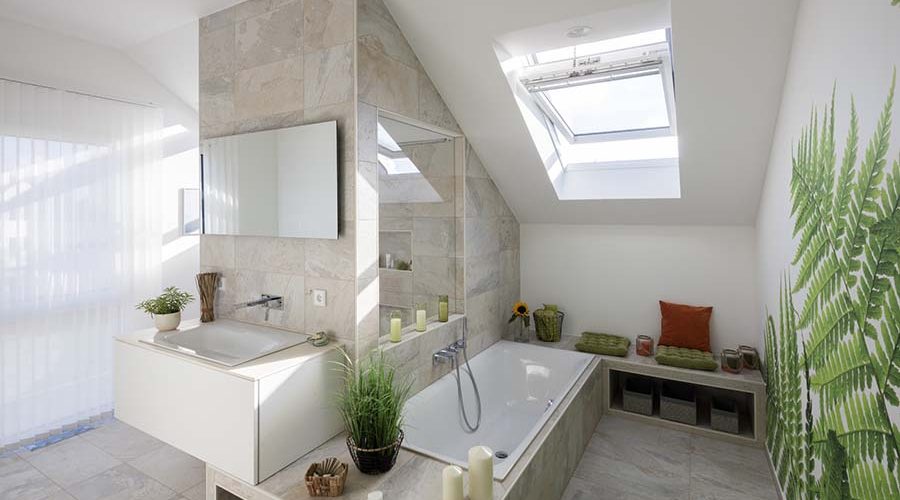Grant Sneddon, Product Manager at roof window manufacturer VELUX, shares his thoughts on how products, such as roof windows, can be a vital element in creating the sustainable public housing of the future.
Velux
According to the National Housing Federation’s (NHF) People in Housing Need Report, there are eight million people in England alone who are experiencing some form of housing need, and a sustainable future for so many of these people would be one where all public housing is built with sustainability principles front and centre.
We all want to live in homes which are healthy, daylight-filled, and provide space for our families to grow. With public perceptions continuing to shift, social
housing tenants, in particular, have become even more aware of the positive impact that healthy, sustainable homes can have on the way they live.
There have been some fantastic successes across the globe with sustainability incorporated into the very core of new public housing schemes. And through my experience working at VELUX, I know that there are also some simple glazing additions that can help ensure more sustainable homes can be developed for everyone, regardless of the tenure of the home they live in.
Incorporating roof windows in a build is always an easy way to boost the credentials of a home, and this is no different for social housing. Creating properties which are daylight-filled, well-ventilated and incorporate sustainable development principles are factors which lead to the creation of healthy homes. And healthy homes tend to provide good thermal comfort, meaning that there’s less need to flick on the central heating or plug-in fans as they are built using products which are cleverly designed to reduce a property’s carbon footprint.
When it comes to windows, glazing can be just as sustainable as the rest of the materials that form part of a sustainable social housing development. Well-designed and carefully-crafted glazing can provide unparalleled heat insulation and solar gain in winter months, and with toughened inner and outer panes, quality roof and vertical windows can also protect against inclement weather. Triple-glazed roof windows are also the best option to achieve optimum noise reduction and thermal performance.
We consider this so important that our patented ThermoTechnology comes as standard with VELUX roof windows, and provides an airtight seal to promote complete energy efficiency. They also come with ventilation bars, so homeowners can allow fresh air to flow into the home while keeping the heat in. Both of these elements also work in tandem with features such as our white polyurethane frame finish, which conceals all the frame’s joints and is moisture resistant to prevent issues like damp or mould that could occur in more humid rooms, such as bathrooms or kitchens.
Choosing glazing that has been crafted with sustainability in mind, as well as opting for solar-powered ‘upgrades’ over electric ones, can lead to a reduction in gas, electric and central heating costs. For a tenant, this reduction in their use of fossil fuels can also result in more sustainable living costs, and means they can also be safe in the knowledge they are also contributing to a healthier environment in the eco-system that they are part of.
What’s more, new smart roof window technology can improve people’s indoor climates by monitoring the temperature, humidity and carbon dioxide levels in their home and opening and closing their roof windows accordingly.
Above all else, roof windows should have a positive carbon footprint story – from cradle to final disposal. For example, during a 40-year lifespan of a wooden, triple-glazed VELUX roof window that has had its glazing replaced after 20 years, approximately 184kg of carbon dioxide will be produced from raw materials, production outputs and final disposal of any parts that cannot be recycled. However, the use phase produces a total of -502kg of carbon dioxide emissions to replenish this loss, which is a direct result of the roof windows and accessories we develop which contribute towards reducing heat loss and maximising solar gain.
As a business, VELUX has also made a commitment to become lifetime carbon-neutral by 2041. Broadly speaking, our ‘decade of action’ means that the business will be working to account for all past and future carbon emissions through energy management to combat CO2 production, mainly resulting from the use of raw materials in our products, such as wood, glass and various metals and other materials. We will also be promoting a circular economy for our roof windows through initiatives such as reforestation projects.
As an industry, we must all make an effort to reduce our impact on the environment. The public housing process should be no different, and incorporating simple glazing additions can be the easy first step to a future where all public sector design and build work is sustainably driven for the good of all those who use them, now and in the future.









